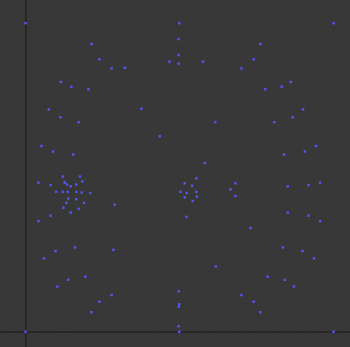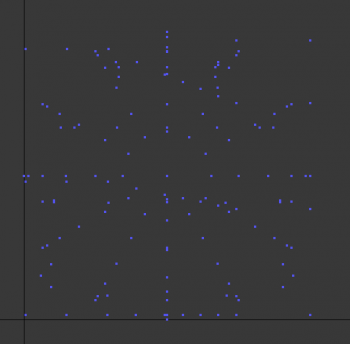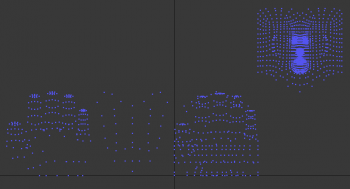Page 1 of 1
Various UV representations
Posted: Sat Jan 03, 2015 4:53 am
by JohnHudeski
Hi guys I am having a ridiculously difficult time figuring out the UV files for a model I ripped.
I have been able to extract everything from this game except UV
So i am hoping to compile here a list of every method UV can be represented to aid my research
First question, is there a special way UV's are organized when the texture is tiled or swizzled?
You will find below an example of said file
Code: Select all
struct UVHeader
{
int vertCount; //or id
int type; //14, 15 or 16
int size; //size of each uv
int dataSize; //vertCount * size = dataSize
}
//Type is associated with size
//Type:Size 14:8, 15:12, 16:16
//I assume in some cases they have 2 UVs
struct UnknStruct00
{
int i0; //always 1
int i1; //always 1
int i2; //always 0
int i3; //always 0
int i4; //always 0
int i5; //Always a Constant -65536 (which is the minimum short value)
int i6; //UV offset
ushort s0,s1; //always 4096 and another increasing value
};
This class doesn't seem important
I had originally thought [b]i5[/b] was a bias but i did not know what to scale it to and why that was necessary.
The UV's always have a prefix of 0xFFFF regardless of data being read 4,12,16
0xFFFF word (word, word)
I tried reading the word values as half floats and floats but I always come across negative values or so ridiculous E value
Hence I believe them to be integers
Been staring at this for a long time
Re: Various UV representations
Posted: Sat Jan 03, 2015 9:18 am
by shakotay2
did you try out unsigned shorts?
# 0x34 (UVBlockSize= 8 )
vt 0.125702 0.332901
vt 0.375687 0.852448
vt 0.360168 0.661026
vt 0.188293 0.196213
vt 0.875824 0.817276
vt 0.782074 0.352463
vt 0.305557 0.832901
vt 0.266495 0.368088
vt 0.200104 0.793839
vt 0.262604 0.329025
vt 0.000900 0.754776
vt 0.039963 0.317307
vt 0.125702 0.332901
vt 0.360168 0.661026
vt 0.375687 0.852448
vt 0.188293 0.196213
vt 0.875824 0.817276
vt 0.782074 0.352463
vt 0.305557 0.832901
vt 0.266495 0.368088
vt 0.200104 0.793839
vt 0.262604 0.329025
vt 0.000900 0.754776
vt 0.039963 0.317307
vt 0.149307 0.813339
vt 0.047745 0.625732
vt 0.297760 0.219604
vt 0.289948 0.563248
vt 0.422775 0.032120
vt 0.602463 0.125778
vt 0.188171 0.688354
vt 0.000366 0.719559
vt 0.016418 0.844589
vt 0.063263 0.063263
vt 0.875824 0.469589
vt 0.125824 0.375717
vt 0.297760 0.219604
vt 0.047745 0.625732
vt 0.149307 0.813339
vt 0.125824 0.375717
vt 0.875824 0.469589
vt 0.063263 0.063263
vt 0.016418 0.844589
vt 0.000366 0.719559
vt 0.188171 0.688354
vt 0.602463 0.125778
vt 0.289948 0.563248
vt 0.422775 0.032120
vt 0.000916 0.277924
vt 0.000916 0.020416
vt 0.121979 0.277924
vt 0.778214 0.082916
vt 0.286011 0.277924
vt 0.879745 0.875885
vt 0.160965 0.277924
vt 0.559387 0.586838
vt 0.144989 0.277924
vt 0.144989 0.524338
vt 0.160965 0.277924
vt 0.559387 0.586838
vt 0.286011 0.277924
vt 0.879745 0.875885
vt 0.778214 0.082916
vt 0.121979 0.277924
vt 0.286011 0.277924
vt 0.778214 0.082916
vt 0.121979 0.762619
vt 0.160965 0.277924
vt 0.144989 0.277924
vt 0.160965 0.277924
vt 0.286011 0.277924
vt 0.778214 0.082916
vt 0.121979 0.277924
vt 0.000916 0.020416
vt 0.000916 0.277924
vt 0.000916 0.762619
vt 0.000916 0.020416
vt 0.000916 0.277924
vt 0.000916 0.020416
vt 0.000916 0.277924
vt 0.121979 0.277924
vt 0.121979 0.762619
vt 0.000916 0.762619
If these don't work you'll need an "unswizzle expert".
Re: Various UV representations
Posted: Sat Jan 03, 2015 10:25 am
by Chipicao
It's hard to tell with such a small UV set. Can you upload something bigger?
@shakotay2 you're reading little endian in a big endian file
Re: Various UV representations
Posted: Sat Jan 03, 2015 3:55 pm
by JohnHudeski
I don't know how you got those values but here is something bigger
The whole UV set for a model.
20 shapes in order. I couldn't auto calculate the offsets but here are the copied headers
Code: Select all
//Big Endian file
struct UVHeader
{
int vertCount; //or id
int type; //14,15,16
int uvSize; //8,12,16 (single uv size)
int totalSize; //vertCount * uvSize= totalSize
}uvHeader[20]
Re: Various UV representations
Posted: Sun Jan 04, 2015 6:12 am
by JohnHudeski
I don't know if I need to post textures also.
They are all crazy like this (used
this).
Re: Various UV representations
Posted: Sun Jan 04, 2015 10:30 am
by Chipicao
They are definitely half floats, I don't know how you missed them. Are you sure you tried reading them as
big endian halves and not little endian?
Here is U #20 - type 14 - 1558 vertices:

UV #1 - type 15 - 439 vertices - this could be your eye (unswizzled):

UV #17 - type 16 - 2257 vertices:

Re: Various UV representations
Posted: Sun Jan 04, 2015 2:12 pm
by JohnHudeski
I saw negative values along the way
Never heard of negative uvs.
Half floats were my first thought as well
But I came across version 15 and 16 this confused me. still confuses me
I also do not know how to represent half floats in C# without reverting to unsafe code so I was easily persuaded
I cannot believe I never thought to plot them out. Cos I did so for the bones and verts.
This game stored bone weights in vector3's
After figuring this out, I hope it will be easy to find out how textures are assigned from xpr2
cos the texture names are magic
Re: Various UV representations
Posted: Sun Jan 04, 2015 4:08 pm
by Chipicao
Negative values for UV coordinates are not unheard of.
Yes, in most cases they range from 0 to 1.0, but for example the artist could scale the UV for a tiled texture and not care if it gets negative coordinates.
Other times the whole UV may be shifted by a multiple of +/-1.0, as you can see in my third screenshot. Anything can happen in the mapping process, and if the format allows negative coordinates, the artist won't care.
As for the various types, here's how I see it:
type14 (8bytes):
uint8 color.R
uint8 color.G
uint8 color.B
uint8 color.A
half texture0.x
half texture0.y
type15 (12bytes):
uint8 color.R
uint8 color.G
uint8 color.B
uint8 color.A
half texture0.x
half texture0.y
half texture1.x
half texture1.y
type16 (16bytes):
uint8 color.R
uint8 color.G
uint8 color.B
uint8 color.A
half texture0.x
half texture0.y
half texture1.x
half texture1.y
half texture2.x
half texture2.y
So there are up to 3 UV channels. Yes, some coordinates are 0, but not all. I did plot the other two UVs and they look good.
I'm not 100% sure about the color, but it wouldn't be uncommon to store it along UVs, and white opaque would be default (FF FF FF FF).
I've used this in the past for reading half floats, maybe it will help:
http://csharp-half.sourceforge.net/
Good luck!
Re: Various UV representations
Posted: Sun Jan 04, 2015 4:20 pm
by JohnHudeski
Thank you so very much. Please don't take 2 weeks holiday ever again

I read a lot about half floats after seeing your post ( I went to bed with the laptop lol)
I'll check out that library. This is what I found before.
Code: Select all
using System;
using System.Collections.Generic;
using System.Linq;
using System.Text;
using System.Threading.Tasks;
namespace HalfFloat
{
class Program
{
static void Main(string[] args)
{
{
string hex = "0x3862";
short h = Convert.ToInt16(hex, 16);
//From this paper ftp://www.fox-toolkit.org/pub/fasthalffloatconversion.pdf
float f = ((h & 0x8000) << 16) | (((h & 0x7c00) + 0x1C000) << 13) | ((h & 0x03FF) << 13);
Console.Write("Short h {0}: is Float {1} //" + h.ToString("X"), h, f);
//Same as the half float in 010 Editor
//http://codereview.stackexchange.com/questions/45007/half-precision-reader-writer-for-c
f = HalfFloat(Convert.ToInt32(hex, 16));
Console.Write("\nShort h {0}: is Float {1} //" + h.ToString("X"), h, f);
}
//I thought we had to flip the hex for Big endians? This failed
{
string hex = "0x6238";
short h = Convert.ToInt16(hex, 16);
float f = ((h & 0x8000) << 16) | (((h & 0x7c00) + 0x1C000) << 13) | ((h & 0x03FF) << 13);
Console.Write("\nShort h {0}: is Float {1} //" + h.ToString("X"), h, f);
f = HalfFloat(Convert.ToInt32(hex, 16));
Console.Write("\nShort h {0}: is Float {1} //" + h.ToString("X"), h, f);
}
Console.ReadKey();
}
// ignores the higher 16 bits
public static float HalfFloat(int hbits)
{
int mant = hbits & 0x03ff; // 10 bits mantissa
int exp = hbits & 0x7c00; // 5 bits exponent
if (exp == 0x7c00) // NaN/Inf
exp = 0x3fc00; // -> NaN/Inf
else if (exp != 0) // normalized value
{
exp += 0x1c000; // exp - 15 + 127
if (mant == 0 && exp > 0x1c400) // smooth transition
return BitConverter.ToSingle(BitConverter.GetBytes((hbits & 0x8000) << 16
| exp << 13 | 0x3ff),0);
}
else if (mant != 0) // && exp==0 -> subnormal
{
exp = 0x1c400; // make it normal
do
{
mant <<= 1; // mantissa * 2
exp -= 0x400; // decrease exp by 1
} while ((mant & 0x400) == 0); // while not normal
mant &= 0x3ff; // discard subnormal bit
} // else +/-0 -> +/-0
return BitConverter.ToSingle(
BitConverter.GetBytes( // combine all parts
(hbits & 0x8000) << 16 // sign << ( 31 - 15 )
| (exp | mant) << 13),0); // value << ( 23 - 10 )
}
}
}


